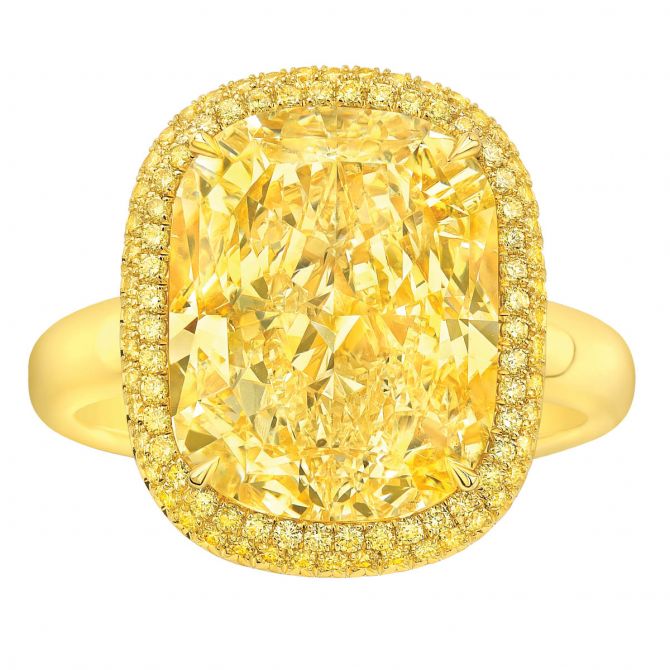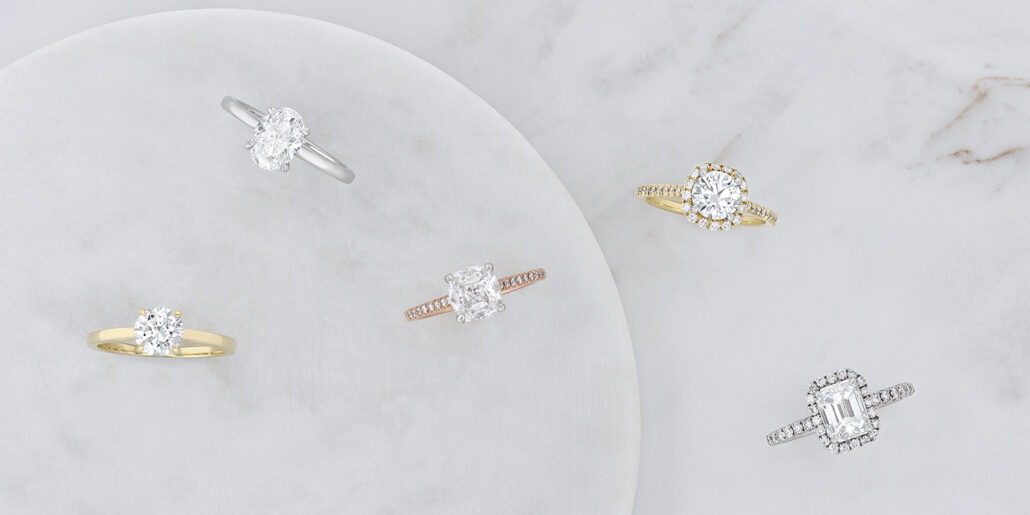Once upon a time, there was no agreed-upon standard for evaluating diamonds. Then, in the 1940s, the founder of the GIA, Robert Shipley, coined the term “4Cs” to describe the four factors that characterize a faceted diamond: color, clarity, cut and carat weight. Today, the 4Cs of Diamond Quality is a universal method for assessing the quality of a diamond. The 4Cs revolutionized the diamond industry – making it possible for diamond quality to be communicated in a universal language and for diamond buyers to know exactly what they are purchasing. Read on to learn more about the 4Cs and how they each impact a diamond’s quality and value.
Diamond Cut
A diamond’s cut determines how well the diamond interacts with light. Cut also refers to how well the diamond is faceted, proportioned and polished. Often considered the most important and complex of the 4Cs, a diamond’s cut has the greatest influence on a diamond’s beauty and sparkle. Cut is unique because it’s the only one of the 4Cs that’s not influenced by nature.
GIA’s diamond cut grade predicts brightness, fire, and scintillation, which indicate how well a diamond’s proportions work together to return white and colored light to the observer. Face-up appearance, design & craftsmanship are critical to a diamond’s overall cut quality. Weight ratio, durability, polish & symmetry are all included in GIA’s Diamond Cut Grading System. Fancy-cut diamonds such as pear or heart-shaped diamonds do not have GIA cut grades because there are broader parameters for their proportions and facet arrangements.

Round Cut

Princess Cut

Radiant Cut

Cushion Cut

Asscher Cut

Emerald Cut

Oval Cut

Marquise Cut

Pear Cut

Heart Cut
Diamond Color
Color in the 4C’s measures a diamond’s absence of color because most “colorless” or “white” diamonds contain trace amounts of a yellow, brown or gray color. The diamond color scale below reflects how closely a diamond approaches the colorless range. Diamonds are graded on the D-to-Z scale, with D meaning that a diamond has no detectable color and Z meaning that a diamond has “light” coloring. Although most people recognize diamonds as colorless, truly colorless diamonds are very rare and make up a small fraction of all mined diamonds; therefore, most jewelry is made using diamonds in the near-colorless range. Most people cannot see a color difference when comparing different color grades, although there can be a significant price difference.

Diamonds are also available in various colors, including red, purple, pink, green, orange, yellow, blue, brown and black. These rare and unique diamonds are termed “fancy color diamonds” and are graded based on their hue, tone and saturation—the more intense the color, the higher the rarity factor. The rarest of the fancy-colored diamonds is red.

Diamond Carat
Simply put, diamond carat weight measures how much a diamond weighs. Diamonds are weighed on a scale of metric carats, abbreviated “ct.” A metric carat is defined as 200 milligrams or approximately 1/5 of a gram. Each carat is subdivided into 100 points, just like a dollar is broken down into 100 pennies. When you see a diamond weight of 1.45ct, it means one carat and 45 points. The larger a diamond is, the rarer it is and thus more valuable. Diamonds are bought and sold on a pricing concept known as “per carat.”

0.50 Carats

1.00 Carats

1.50 Carats

2.00 Carats

3.00 Carats

4.00 Carats
Diamond Clarity
A diamond’s clarity grade is the degree to which it is free of inclusions and blemishes. Nature produces very few “perfect” objects. Most diamonds have internal birthmarks, called inclusions, and external characteristics, known as blemishes. These clarity characteristics are evaluated under 10X magnification by trained diamond graders based on the number, size, relief, nature and position of these characteristics. While no diamond is perfectly pure, the closer it comes to purity, the better its clarity.
The GIA’s Diamond Clarity Scale has six categories by which it grades diamond clarity:
- Flawless (FL): No inclusions and no blemishes visible under 10x magnification.
- Internally Flawless (IF): No inclusions visible under 10x magnification.
- Very, Very Slightly Included (VVS1 and VVS2): Inclusions so slight they are difficult for a skilled grader to see under 10x magnification.
- Very Slightly Included (VS1 and VS2): Inclusions are observed with effort under 10x magnification but can be characterized as minor.
- Slightly Included (SI1 and SI2): Inclusions are noticeable under 10x magnification.
- Included (I1, I2, and I3): Inclusions are obvious under 10x magnification, which may affect transparency and brilliance.

Now that you have an understanding of what the 4Cs are, it is essential to remember that a diamond’s value is determined using all of the 4Cs in combination. For example, just because one diamond has a higher carat weight than another, it may have a lower quality cut or color grade, affecting its overall value.
If you need help picking out the perfect diamond, one of our experts would be happy to assist you. Stop into our store or text or call 402.391.0400 during store hours to speak with one of our friendly and knowledgeable sales associates.

